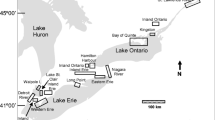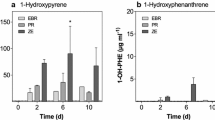Abstract
Cytochrome P450 (CYP) enzymes catalyse the oxidative metabolism of various xenobiotics including environmental pollutants. We investigated liver microsomal CYP marker activities in 60 paradise shelducks (Tadorna variegata; herbivore) and 77 southern black-backed gulls (Larus dominicanus; omnivore) collected at three sites with putatively different levels of pollution in the South Island of New Zealand. Ethoxyresorufin O-deethylase (EROD) activity was high in birds at an urban landfill site compared to those at a relatively pristine and an agricultural site. Analysis of p-nitrophenol hydroxylase and erythromycin demethylase activities indicated the presence of two additional CYP isoforms in shelducks but no additional form in gulls. Total polychlorinated biphenyl (PCB) concentrations (ranges: shelducks, 0.073–6.2; gulls, 8.2–330 ng/g wet weight) were high in landfill samples suggesting a link to EROD induction and, in landfill shelducks, EROD was independently associated with Hg and Pb concentration. PCB congener-specific assessments indicated the metabolism of at least two congeners (#28 and #74) is induced in shelducks. DDE concentrations (ranges: shelducks, 0.85–320; gulls, 44–4800 ng/g) were high in birds at the landfill and agricultural sites. Body weight tended to be lower in landfill birds, but whether this reflects the greater energetic demands of pollutant detoxification remains to be investigated.



Similar content being viewed by others
References
ATSDR (Agency for Toxic Substances, Disease Registry) (2002) Toxicological profile for DDT, DDE, and DDD. ATSDR, US Department of Health and Human Services, GA, USA
Bellward GD, Norstrom RJ, Whitehead PE, Elliott JE, Bandiera SM, Dworschak C, Chang T, Forbes S, Cadario B, Hart LE (1990) Comparison of polychlorinated dibenzodioxin levels with hepatic mixed-function oxidase induction in great blue herons. J Toxicol Environ Health 30:33–52
Bend JR, Miller DS, Kinter WB, Peakall DB (1977) DDE-induced microsomal mixed-function oxidases in the puffin (Fratercula arctica). Biochem Pharmacol 26:1000–1001
Blus LJ (1996) DDT, DDD, and DDE in birds. In: Beyer WN, Heinz GH, Redmon-Norwood AW (eds) Environmental contaminants in wildlife: interpreting tissue concentrations. CRC Press, FL, USA, pp 49–71
Boon JP, van der Meer J, Allchin CR, Law RJ, Klungsøyr J, Leonards PEG, Spliid H, Storr-Hansen E, Mckenzie C, Wells DE (1997) Concentration-dependent changes of PCB patterns in fish-eating mammals: structural evidence for induction of cytochrome P450. Arch Environ Contam Toxicol 33:298–311
Borlakoglu JT, Haegele KD (1991) Comparative aspects on the bioaccumulation, metabolism and toxicity with PCBs. Comp Biochem Physiol 100C:327–338
Borlakoglu JT, Welch VA, Edwards-Webb JD, Dils RR (1990) Transport and cellular uptake of polychlorinated biphenyls (PCBs)––II changes in vivo in plasma lipoproteins of pigeons in response to PCBs, and a proposed model for the transport and cellular uptake of PCBs. Biochem Pharmacol 40:273–281
Brüschweiler BJ, Würgler FE, Fent K (1996) Inhibitory effects of heavy metals on cytochrome P4501A induction in permanent fish hepatoma cells. Arch Environ Contam Toxicol 31:475–482
Buckland SJ, Ellis HK, Salter RT (1996) Assessment of the New Zealand environment for levels of PCDDs, PCDFs, PCBs and other organochlorine contaminants. Organohalogen Compound 28:140–145
Drouillard KG, Norstrom RJ (2003) The influence of diet properties and feeding rates on PCB toxicokinetics in the ring dove. Arch Environ Contam Toxicol 44:97–106
Elliot JE, Martin PA (1998) Chlorinated hydrocarbon contaminants in grebes and seaducks wintering on the coast of British Columbia, Canada: 1988–1993. Environ Monit Assess 53:337–362
Fox GA, Trudeau S, Wou H, Grasman KA (1998) Monitoring the elimination of persistent toxic substances from the Great Lakes; chemical and physiological evidence from adult herring gulls. Environ Monit Assess 53:147–168
Fujihara J, Kunito T, Kubota R, Tanabe S (2003) Arsenic accumulation in livers of pinnipeds, seabirds and sea turtles: subcellular distribution and interaction between arsenobetaine and glycine betaine. Comp Biochem Physiol 136C:287–296
Guengerich FP (2001) Analysis and characterization of enzymes and nucleic acids. In: Hayes AW (ed) Principles and methods of toxicology, 4th edn. Taylor & Francis, PA, USA, pp 1625–1687
Hahn ME (2002) Biomarkers and bioassays for detecting dioxin-like compounds in the marine environment. Sci Total Environ 289:49–69
Heather BD, Robertson HA (2000) The field guide to the birds of New Zealand. Penguin Books, Auckland, New Zealand
Hebert CE, Keenleyside KA (1995) To normalize or not to normalize? Fat is the question. Environ Toxicol Chem 14:801–807
Helsel DR (1990) Less than obvious: statistical treatment of data below the detection limit. Environ Sci Tech 24:1766–1774
Holland P, Rahman A (1999) Review of trends in agricultural pesticide use in New Zealand. MAF Policy Technical Paper 99/11, Ministry of Agriculture and Forestry, Wellington, New Zealand
Kim SG, Williams DE, Schuetz EG, Guzelian PS, Novak RF (1988) Pyridine induction of cytochrome P-450 in the rat: role of P450j (alcohol-inducible form) in pyridine N-oxidation. J Pharmacol Exp Ther 246:1175–1182
Kitada M, Igoshi N, Kamataki T, Itahashi K, Imaoka S, Komori M, Funae Y, Rikihisa T, Kanakubo Y (1988) Immunochemical similarity of P-450 HFLa, a form of cytochrome P-450 in human fetal livers, to a form of rat liver cytochrome P-450 inducible by macrolide antibiotics. Arch Biochem Biophys 264:61–66
Korashy HM, El-Kadi AOS (2004) Differential effects of mercury, lead and copper on the constitutive and inducible expression of aryl hydrocarbon receptor (AHR)-regulated genes in cultured hepatoma Hepa 1c1c7 cells. Toxicology 201:153–172
Kramer HJ (2001) Comparative toxicokinetics of tetrachlorobenzyltoluenes (TCBTs) and polychlorobiphenyls (PCBs). PhD thesis, University of Utrecht, Utrecht, the Netherlands
Lewis DF (2000) On the recognition of mammalian microsomal cytochrome P450 substrates and their characteristics. Biochem Pharmacol 60:293–306
Lowry OH, Rosebrough NJ, Farr AL, Randall RJ (1951) Protein measurement with the Folin phenol reagent. J Biol Chem 193:265–275
Machala M, Mátlová L, Svoboda I, Nezveda K (1996) Induction effects of polychlorinated biphenyls, polycyclic aromatic hydrocarbons and other widespread aromatic environmental pollutants on microsomal monooxygenase activities in chick embryo liver. Arch Toxicol 70:362–367
Matsusue K, Ariyoshi N, Oguri K (1996) Involvement of cytochrome b5 in the metabolism of tetrachlorobiphenyls catalyzed by CYP2B1 and CYP1A1. Chemosphere 32:517–523
Mertz W (ed) (1986) Trace elements in human and animal nutrition, 5th edn. Academic Press, NY, USA
Ministry for the Environment (1998) Organochlorines in New Zealand: ambient concentrations of selected organochlorines in soils. Ministry for the Environment, Wellington, New Zealand
Ministry for the Environment (1999) Organochlorines in New Zealand: ambient concentrations of selected organochlorines in estuaries. Ministry for the Environment, Wellington, New Zealand
Norstrom RJ, Clark TP, Jeffrey DA, Won HT, Gilman AP (1986) Dynamics of organochlorine compounds in herring gulls (Larus argentatus): I. Distribution and clearance of [14C]DDE in free-living herring gulls (Larus argentatus). Environ Toxicol Chem 5:41–48
Numata M, Fawcett JP, Rosengren RJ, Wanwimolruk S (2004) Ontogeny of hepatic microsomal 3-hydroxylation of quinine in Adélie penguins. Comp Biochem Physiol 138C:53–58
Parkinson A (2001) Biotransformation of xenobiotics. In: Klaassen CD (ed) Casarett & Doull’s toxicology: the basic science of poisons, 6th edn. McGraw-Hill, NY, USA, pp 133–224
Pohl RJ, Fouts JR (1980) A rapid method for assaying the metabolism of 7-ethoxyresorufin by microsomal subcellular fractions. Anal Biochem 107:150–155
Rattner BA, Hoffman DJ, Marn CM (1989) Use of mixed-function oxygenases to monitor contaminant exposure in wildlife. Environ Toxicol Chem 8:1093–1102
Reid H (2000) The levels and implications of PCDD/Fs and PCBs in male Australian harriers. A report prepared for Ministry for the Environment, Institute of Environmental Science and Research, Porirua, New Zealand
Reid H, Jones P (1999) Organochlorine contaminants in Northern Royal Albatross from Taiaroa Head, Otago Peninsula. A report prepared for the Department of Conservation, Institute of Environmental Science and Research, Porirua, New Zealand
Rendic S (2002) Summary of information on human CYP enzymes: human P450 metabolism data. Drug Metab Rev 34:83–448
Rich KJ, Boobis AR (1997) Expression and inducibility of P450 enzymes during liver ontogeny. Microsc Res Tech 39:424–435
Rifkind AB (2006) CYP1A in TCDD toxicity and in physiology – with particular reference to CYP dependent arachidonic acid metabolism and other endogenous substrates. Drug Metab Rev 38:291–335
Risebrough RW, Walker W II, Schmidt TT, de Lappe BW, Connors CW (1976) Transfer of chlorinated biphenyls to Antarctica. Nature 264:738–739
Risso-de Faverney C, Lafaurie M, Girard J-P, Rahmani R (2000) Effects of heavy metals and 3-methylcholanthrene on expression and induction of CYP1A1 and metallothionein levels in trout (Oncorhynchus mykiss) hepatocyte cultures. Environ Toxicol Chem 19:2239–2248
Sagerup K, Henriksen EO, Skaare JU, Gabrielsen GW (2002) Intraspecific variation in trophic feeding levels and organochlorine concentrations in glaucous gulls (Larus hyperboreus) from Bjørnøya, the Barents Sea. Ecotoxicology 11:119–125
Scheuhammer AM (1987) The chronic toxicity of aluminium, cadmium, mercury, and lead in birds: a review. Environ Pollut 46:263–295
Skřivan M, Skřivanová V, Marounek M (2006) Effects of various copper supplements to feed of laying hens on Cu content in eggs, liver, excreta, soil, and herbage. Arch Environ Contam Toxicol 50:280–283
Sokal RR, Rohlf FJ (1995) Biometry: the principles and practice of statistics in biological research 3rd edn. WH Freeman and Company, NY, USA
Vakharia DD, Liu N, Pause R, Fasco M, Bessette E, Zhang Q-Y, Kaminsky LS (2001) Effect of metals on polycyclic aromatic hydrocarbon induction of CYP1A1 and CYP1A2 in human hepatocyte cultures. Toxicol Appl Pharmacol 170:93–103
van den Berg M, Birnbaum L, Bosveld ATC, Brunström B, Cook P, Feeley M, Giesy JP, Hanberg A, Hasegawa R, Kennedy SW, Kubiak T, Larsen JC, van Leeuwen FXR, Liem AKD, Nolt C, Peterson RE, Poellinger L, Safe S, Schrenk D, Tillitt D, Tysklind M, Younes M, Wærn F, Zacharewski T (1998) Toxic equivalency factors (TEFs) for PCBs, PCDDs, PCDFs for humans and wildlife. Environ Health Perspect 106:775–792
Walker CH (1998) Avian forms of cytochrome P450. Comp Biochem Physiol 121C:65–72
Yamashita N, Shimada T, Tanabe S, Yamazaki H, Tatsukawa R (1992) Cytochrome P-450 forms and its inducibility by PCB isomers in black-headed gulls and black-tailed gulls. Mar Pollut Bull 24:316–321
Acknowledgements
We are grateful for the assistance of Frans Laas in sample collection. We also thank the Otago Fish and Game Council, the Department of Conservation Otago and West Coast Conservancies, and the landfill operators, Delta Utility Services and EnviroWaste Services. Pollutant analyses were supervised by Claire Hiess (AgriQuality) and Tracy Morrison (Environmental Laboratory Services). M. Numata was financially supported by a University of Otago School of Pharmacy Stipend.
Author information
Authors and Affiliations
Corresponding author
Rights and permissions
About this article
Cite this article
Numata, M., Fawcett, J.P., Saville, D.J. et al. Hepatic cytochrome P450 activity and pollutant concentrations in paradise shelducks and southern black-backed gulls in the South Island of New Zealand. Ecotoxicology 17, 697–708 (2008). https://doi.org/10.1007/s10646-008-0218-9
Received:
Accepted:
Published:
Issue Date:
DOI: https://doi.org/10.1007/s10646-008-0218-9




